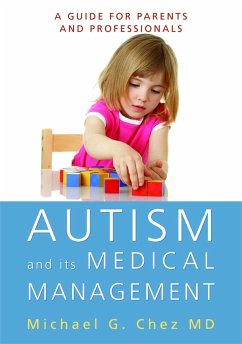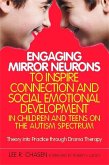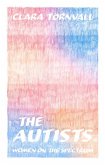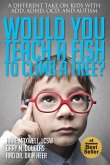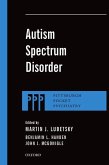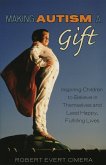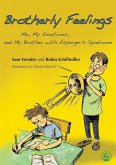- Broschiertes Buch
- Merkliste
- Auf die Merkliste
- Bewerten Bewerten
- Teilen
- Produkt teilen
- Produkterinnerung
- Produkterinnerung
The book explains the medical aspects of autism and how parents and professionals can use current medical knowledge to understand how to address the medical aspects of autism. Bridging the communication gap between medical professionals and parents, this book offers accessible explanations of medical terminology and treatment relevant to ASDs.
Andere Kunden interessierten sich auch für
![Engaging Mirror Neurons to Inspire Connection and Social Emotional Development in Children and Teens on the Autism Spectrum Engaging Mirror Neurons to Inspire Connection and Social Emotional Development in Children and Teens on the Autism Spectrum]() Lee R ChasenEngaging Mirror Neurons to Inspire Connection and Social Emotional Development in Children and Teens on the Autism Spectrum49,99 €
Lee R ChasenEngaging Mirror Neurons to Inspire Connection and Social Emotional Development in Children and Teens on the Autism Spectrum49,99 €![The Autists The Autists]() Clara TörnvallThe Autists14,99 €
Clara TörnvallThe Autists14,99 €![Would You Teach a Fish to Climb a Tree? Would You Teach a Fish to Climb a Tree?]() Anne MaxwellWould You Teach a Fish to Climb a Tree?19,99 €
Anne MaxwellWould You Teach a Fish to Climb a Tree?19,99 €![Autism Spectrum Disorder Autism Spectrum Disorder]() Martin J LubetskyAutism Spectrum Disorder91,99 €
Martin J LubetskyAutism Spectrum Disorder91,99 €![Making Autism a Gift Making Autism a Gift]() Robert Evert CimeraMaking Autism a Gift15,99 €
Robert Evert CimeraMaking Autism a Gift15,99 €![Brotherly Feelings Brotherly Feelings]() Sam FrenderBrotherly Feelings20,99 €
Sam FrenderBrotherly Feelings20,99 €
The book explains the medical aspects of autism and how parents and professionals can use current medical knowledge to understand how to address the medical aspects of autism. Bridging the communication gap between medical professionals and parents, this book offers accessible explanations of medical terminology and treatment relevant to ASDs.
Produktdetails
- Produktdetails
- Verlag: Jessica Kingsley Publishers
- Seitenzahl: 224
- Erscheinungstermin: 15. Oktober 2009
- Englisch
- Abmessung: 245mm x 176mm x 14mm
- Gewicht: 454g
- ISBN-13: 9781849058179
- ISBN-10: 1849058172
- Artikelnr.: 26474920
- Herstellerkennzeichnung
- Libri GmbH
- Europaallee 1
- 36244 Bad Hersfeld
- gpsr@libri.de
- Verlag: Jessica Kingsley Publishers
- Seitenzahl: 224
- Erscheinungstermin: 15. Oktober 2009
- Englisch
- Abmessung: 245mm x 176mm x 14mm
- Gewicht: 454g
- ISBN-13: 9781849058179
- ISBN-10: 1849058172
- Artikelnr.: 26474920
- Herstellerkennzeichnung
- Libri GmbH
- Europaallee 1
- 36244 Bad Hersfeld
- gpsr@libri.de
Michael G. Chez MD
Preface. Introduction and Reader Guide. Part I: Autism Overview 1. What is
Normal Development and Does My Child Have Autism? 2. Understanding the
Diagnosis of Autism. Part II: Definitions 3. Defining the Clinical Aspects
of Autism Spectrum Disorders. 4. What Type of Autistic Spectrum Disorder
Does My Child Have? (Non-Regressive Autism, Regressive Autism Syndromes,
Asperger's Subtype, Secondary ASD). 5. Current Recommendations For Medical
Evaluation of ASDs. 6. The Role of Medical Laboratory Diagnostic Testing in
Autism Diagnosis. 7. Neuroanatomy and Neuroimaging in ASDs. 8.
Electroencephalography (EEG): The Relationship of Epilepsy or Epileptic
Activity in ASDs. 9. Genetics. Part III: Theories On Autism Spectrum
Disorders 10. Are Autism Spectrum Disorders Increasing And Why? 11.
Vaccinations, Mercury, And Autism.12. Immunology and Autoimmunity: Is There
a Relationship to ASD? 13. Theories on a Prenatal Cause of Autism Chapter.
14. Alternative Medicine Theories on Autism. Part IV: Treating Autistic
Spectrum Disorders 15. Overview of Treatment of Autism. 16. Picking A
Physician. 17. Non-Medically Sanctioned Alternative Groups Promoting
Therapy for Autistic Spectrum Disorders and Gluten Casein Sensitivity. 18.
Overview of Medicines For Autism: No Cure But Symptomatic Treatments Can
Help. Part V: Neurologically Managing Clinical Aspects of ASD With
Medication 19. Medicines Prescribed for Behavioral Problems in ASD. 20.
Treating EEG Abnormalities and Epilepsy in ASD. 21. Immunological Medical
Therapy in Autism. 22. Gastrointestinal Issues and Autism Spectrum
Disorders. 23. Medications for Core Symptoms of Language and Behavior. 24.
Rational Approach to Medical Treatment of Autistic Patients: Case Studies.
Appendix 1: Chapter Notes and References. Appendix 2: Glossary. Appendix 3:
Resources. Index.
Normal Development and Does My Child Have Autism? 2. Understanding the
Diagnosis of Autism. Part II: Definitions 3. Defining the Clinical Aspects
of Autism Spectrum Disorders. 4. What Type of Autistic Spectrum Disorder
Does My Child Have? (Non-Regressive Autism, Regressive Autism Syndromes,
Asperger's Subtype, Secondary ASD). 5. Current Recommendations For Medical
Evaluation of ASDs. 6. The Role of Medical Laboratory Diagnostic Testing in
Autism Diagnosis. 7. Neuroanatomy and Neuroimaging in ASDs. 8.
Electroencephalography (EEG): The Relationship of Epilepsy or Epileptic
Activity in ASDs. 9. Genetics. Part III: Theories On Autism Spectrum
Disorders 10. Are Autism Spectrum Disorders Increasing And Why? 11.
Vaccinations, Mercury, And Autism.12. Immunology and Autoimmunity: Is There
a Relationship to ASD? 13. Theories on a Prenatal Cause of Autism Chapter.
14. Alternative Medicine Theories on Autism. Part IV: Treating Autistic
Spectrum Disorders 15. Overview of Treatment of Autism. 16. Picking A
Physician. 17. Non-Medically Sanctioned Alternative Groups Promoting
Therapy for Autistic Spectrum Disorders and Gluten Casein Sensitivity. 18.
Overview of Medicines For Autism: No Cure But Symptomatic Treatments Can
Help. Part V: Neurologically Managing Clinical Aspects of ASD With
Medication 19. Medicines Prescribed for Behavioral Problems in ASD. 20.
Treating EEG Abnormalities and Epilepsy in ASD. 21. Immunological Medical
Therapy in Autism. 22. Gastrointestinal Issues and Autism Spectrum
Disorders. 23. Medications for Core Symptoms of Language and Behavior. 24.
Rational Approach to Medical Treatment of Autistic Patients: Case Studies.
Appendix 1: Chapter Notes and References. Appendix 2: Glossary. Appendix 3:
Resources. Index.
Preface. Introduction and Reader Guide. Part I: Autism Overview 1. What is
Normal Development and Does My Child Have Autism? 2. Understanding the
Diagnosis of Autism. Part II: Definitions 3. Defining the Clinical Aspects
of Autism Spectrum Disorders. 4. What Type of Autistic Spectrum Disorder
Does My Child Have? (Non-Regressive Autism, Regressive Autism Syndromes,
Asperger's Subtype, Secondary ASD). 5. Current Recommendations For Medical
Evaluation of ASDs. 6. The Role of Medical Laboratory Diagnostic Testing in
Autism Diagnosis. 7. Neuroanatomy and Neuroimaging in ASDs. 8.
Electroencephalography (EEG): The Relationship of Epilepsy or Epileptic
Activity in ASDs. 9. Genetics. Part III: Theories On Autism Spectrum
Disorders 10. Are Autism Spectrum Disorders Increasing And Why? 11.
Vaccinations, Mercury, And Autism.12. Immunology and Autoimmunity: Is There
a Relationship to ASD? 13. Theories on a Prenatal Cause of Autism Chapter.
14. Alternative Medicine Theories on Autism. Part IV: Treating Autistic
Spectrum Disorders 15. Overview of Treatment of Autism. 16. Picking A
Physician. 17. Non-Medically Sanctioned Alternative Groups Promoting
Therapy for Autistic Spectrum Disorders and Gluten Casein Sensitivity. 18.
Overview of Medicines For Autism: No Cure But Symptomatic Treatments Can
Help. Part V: Neurologically Managing Clinical Aspects of ASD With
Medication 19. Medicines Prescribed for Behavioral Problems in ASD. 20.
Treating EEG Abnormalities and Epilepsy in ASD. 21. Immunological Medical
Therapy in Autism. 22. Gastrointestinal Issues and Autism Spectrum
Disorders. 23. Medications for Core Symptoms of Language and Behavior. 24.
Rational Approach to Medical Treatment of Autistic Patients: Case Studies.
Appendix 1: Chapter Notes and References. Appendix 2: Glossary. Appendix 3:
Resources. Index.
Normal Development and Does My Child Have Autism? 2. Understanding the
Diagnosis of Autism. Part II: Definitions 3. Defining the Clinical Aspects
of Autism Spectrum Disorders. 4. What Type of Autistic Spectrum Disorder
Does My Child Have? (Non-Regressive Autism, Regressive Autism Syndromes,
Asperger's Subtype, Secondary ASD). 5. Current Recommendations For Medical
Evaluation of ASDs. 6. The Role of Medical Laboratory Diagnostic Testing in
Autism Diagnosis. 7. Neuroanatomy and Neuroimaging in ASDs. 8.
Electroencephalography (EEG): The Relationship of Epilepsy or Epileptic
Activity in ASDs. 9. Genetics. Part III: Theories On Autism Spectrum
Disorders 10. Are Autism Spectrum Disorders Increasing And Why? 11.
Vaccinations, Mercury, And Autism.12. Immunology and Autoimmunity: Is There
a Relationship to ASD? 13. Theories on a Prenatal Cause of Autism Chapter.
14. Alternative Medicine Theories on Autism. Part IV: Treating Autistic
Spectrum Disorders 15. Overview of Treatment of Autism. 16. Picking A
Physician. 17. Non-Medically Sanctioned Alternative Groups Promoting
Therapy for Autistic Spectrum Disorders and Gluten Casein Sensitivity. 18.
Overview of Medicines For Autism: No Cure But Symptomatic Treatments Can
Help. Part V: Neurologically Managing Clinical Aspects of ASD With
Medication 19. Medicines Prescribed for Behavioral Problems in ASD. 20.
Treating EEG Abnormalities and Epilepsy in ASD. 21. Immunological Medical
Therapy in Autism. 22. Gastrointestinal Issues and Autism Spectrum
Disorders. 23. Medications for Core Symptoms of Language and Behavior. 24.
Rational Approach to Medical Treatment of Autistic Patients: Case Studies.
Appendix 1: Chapter Notes and References. Appendix 2: Glossary. Appendix 3:
Resources. Index.

